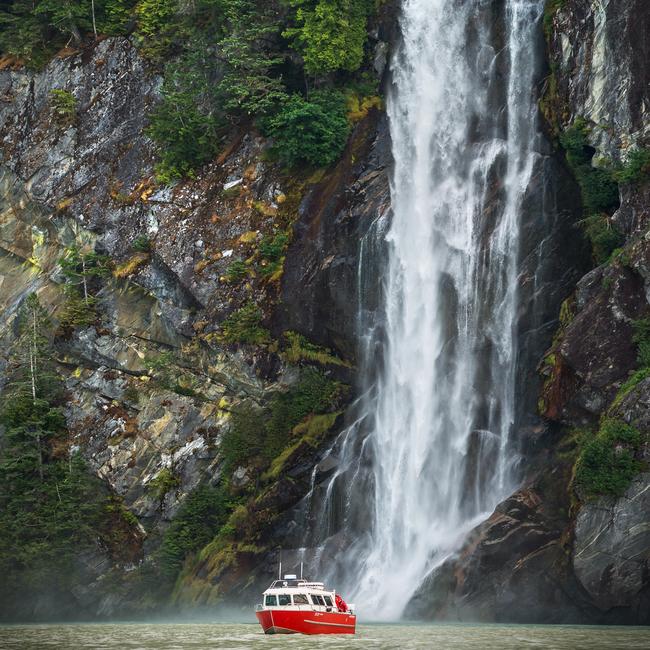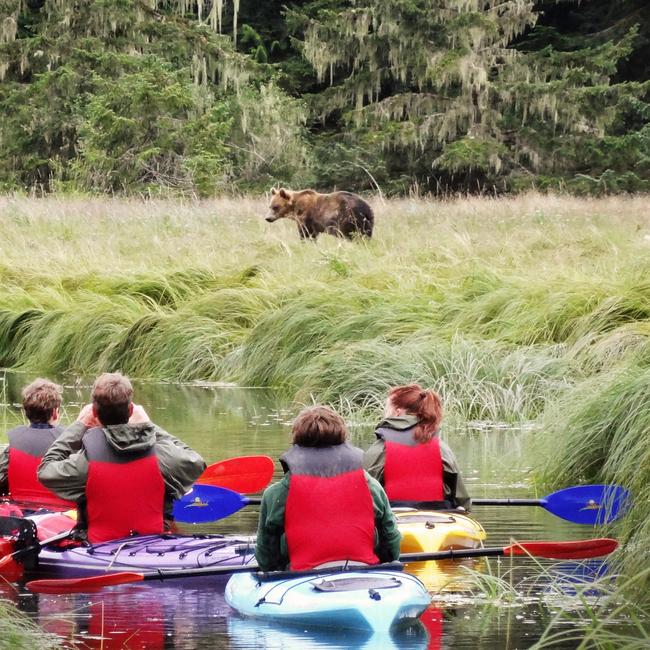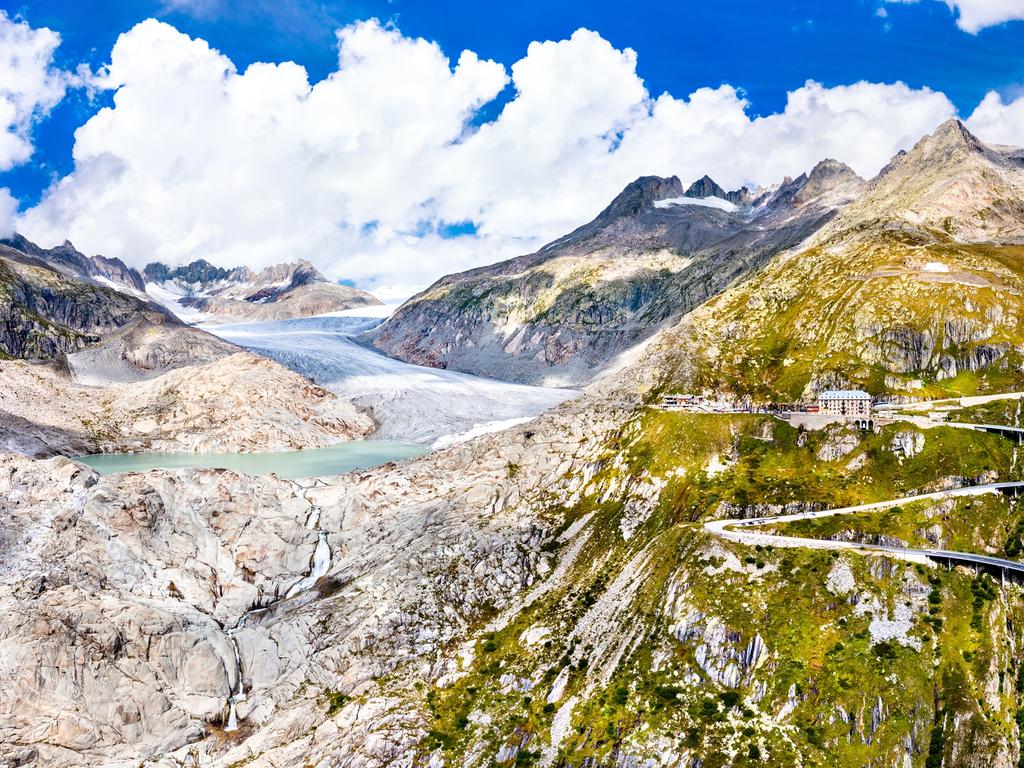Where to spot grizzly bears in Canada
A remote wildlife lodge in British Columbia uses video cameras to track bears, revealing the animals dance when they think no one is watching.

Yesterday, in the forest fair / I saw a bear that wasn’t there. / it wasn’t there again today. / I wish that bear would go away.
Such is the eternal conundrum that is wildlife tracking, and it’s William Hughes Mearns’ classic 1899 poem Antigonish, about a man on a stair who wasn’t there, that my brain processes, deep in the Great Bear Rainforest near Knight Inlet Lodge in British Columbia, Canada.
No one is not here for bears, but best practice demands our guides do their all to ensure there are no encounters, just observations, and on mutually agreed terms.
Which means we should be secured in viewing towers in the forest, or discreetly hovering in boats as they feed at the shoreline.

At other times, when necessarily on foot in the forest, we don’t want to disgruntle a grazing grizzly, and guides need to advise of our presence so the bears can keep what is, to us if not to them, an imperceptible distance. In these circumstances, not seeing bears is an all-round win.
So the guides put out a call, every 15 seconds or so it seems, and on such high rotation their individual mantras instinctively become earworms. Anna Mitchell’s “Ey yoh” mills around in my head as The Banana Boat Song – “Day-o, Day-o, daylight comes and I wanna go home.” Whereas the refrain from her colleague Eddy Savage is vintage Broadway; every time he calls, “Hey bear”, I hear the big first-act ballad from The Pajama Game: “Hey there, you with the stars in your eyes.”

And it’s not just me tapping into the tunes; others in our group admit to humming along.
This is all happening around Knight Inlet Lodge, which resides in glorious wilderness on the longest fjord on the British Columbia coast.
It started life as a low-key fishing lodge but no longer competes with high-end rod-and-reel resorts in neighbouring waterways.
It exists purely for wildlife viewing amid the largest concentration of grizzlies in the province, not that it encroaches on their territory; its 18 motel-style rooms, dining room and lounge float on pontoons secured to the shore in the shelter of Glendale Cove.
The program starts almost immediately after a mid-morning landing in a vintage floatplane that’s brought us from Campbell River on Vancouver Island – there is no land passage into KIL. Its factotum on the island, Harold, has warned us: “This is not a sit-around place, and it is not a zoo. We’re going to keep you very busy because that’s what you need to do to find wildlife.”

Soon we’re in boats out on the cove. It’s autumn, when bears bulk up for hibernation, and they come down to feed on mussels, small fish and grassy sedge before returning to the forest for a berry dessert.
Three boats scout different areas to broaden the chance of sightings. Ours heads up a channel through the sedge flats, in which Mitchell detects tracks where the bears have been some time today, but there are probably none in there now.
Lots of Canadian geese are about, though, and we’re treated to a line of eight flying in perfect formation.
Finally a grizzly is spotted under a tree, albeit 200m away.
We share binoculars to view what is just a dark blob. It’s probably a female because, Mitchell says, males don’t like to be out in the open.
KIL’s packages include up to seven tours, and the first day is set in stone. After the cruise and lunch, there’s a two-hour trip further up the inlet, where “the mountains just keep getting bigger and bigger”, says guide Eddy Savage.

What we can’t see is that, just behind them, is the Silverthrone Caldera, the second largest ice cap in BC and inaccessible from the inlet. But clearly evident is the human story. Savage points out pictographs on a cliff, etched in ochre.
The designs represent wealth and status, the First Nations’ ability to give things away and support the community, Savage says, and he believes their prominence is saying: “Welcome to Glendale Cove”. Landslide scars on other cliffs tell of tragedy. A shell midden that archaeologists found in a clearing opposite is evidence of a village maybe 500 years ago being washed away, without warning, by a 1km-wide wave about 5m high, caused by a landslide on the other side of the inlet.
Later that afternoon, we have our first go at the viewing stands in the forest. The two towers are next to a man-made channel alongside the Glendale River where bears like to dine on salmon caught in the rapids.
“It’s an important time for bears right now,” says Savage. “It’s their pig-out time.” He hears something, a twig breaking probably and, if so, a deliberate act by a bear just to let us know it sees us.

But none reveals itself, although it’s reward enough basking among the hemlocks and red alders in what’s regarded as the richest forest environment in Canada. As our bus begins its return trip, someone finally shouts “bear” when a mother and two cubs walk across a clearing.
For following days we can request whatever activities appeal.
Some guests with big lenses just want to see bears feeding and will return to the stands whenever capacity allows. Otherwise there’s plenty of time on the water, including an all-day whale-watching cruise back around Vancouver Island, plus opportunities to go “Ey yoh-ing” on the forest’s roads and trails. Hence I’m on a tracking tour, “to take a peek into the private life of bears”, as Savage puts it.
We disembark our bus beside tracks heading into the rainforest; a stomp trail that leads to a rub tree. While the rubbing can be to deal with that hard-to-get-to itch, it’s also to leave their scent, and the tree bears prefer the balsam fir.

Its citrusy sap, Savage says, is their cologne, and while it’s not clear just what the purpose is of leaving their scent in a particular spot, it may reveal the age and sex of a bear, for instance a mother with young cubs who doesn’t want to engage with adult males.
Barbed wire looks out of place here yet it’s stretched between trees at an adult bear’s walking height. Savage explains that it harmlessly scrapes off fur to provide DNA for identification and diet information.
Trail cameras also record their behaviour. What do bears do in the woods? Dance like no one is watching, judging by the videos Savage shows us on his phone. But the cameras also feed a facial recognition program that researchers use for the BearID Project that’s been running here since 2014.
We leave the scratching ground and head uphill to a boardwalk, through re-growing logging country, and even at this elevation Savage is crooning his bear ballad.
We arrive at a platform high above the lodge for the perfect view of Knight Inlet. Everything is bathed in sunlight, a warming time for guests and staff alike.

So tucked into the cove is the lodge, that even in summer the earliest it feels the sun is 11am, but the pay-off is the sunsets. KIL’s bar opens at 6pm, and guests gather on the sun-washed deck to toast the solitude. A yacht has been moored across the cove for two days, but otherwise there’s just an occasional day-tour boat from Vancouver Island to break the isolation.
Dinner, at long communal tables, is 7pm sharp, a buffet of hearty dishes and complimentary wine, either from Vancouver Island or an Indigenous mainland winery. We’re usually treated to a song by Kelsey Robinson, currently the lodge’s only Indigenous guide.
A consortium of five First Nations people has owned KIL since 2017, and in that time they’ve achieved much to better the bears’ lot through wild salmon enhancement, forest restoration projects and, vitally, a ban on trophy hunting.

Evening entertainment – there’s no TV, phone or internet – is talks by guides on fauna and ecology, although Robinson goes to his peoples’ struggles over the past 250 years. We hear of smallpox wiping out a vast percentage of the Indigenous population, of a stolen generation created to solve “the Indian issue”, and of an apology from the government in 2008 that, Robinson says, lifted a huge burden from First Nations people. And then the rider: “I don’t think it’s heartfelt yet in Canada.”

Departing guests leave on the floatplane at 10am sharp, but there’s always time for another tour, and this is a reprise of the first morning’s inlet cruise. Within minutes a black bear is spotted near the lodge, breakfasting on barnacles.
So too are a mother grizzly and cub on the other shore. They’re “perfect specimens, so healthy looking”, says boatman Shaun Hill. We return to the dock and soon two floatplanes make their steep descent. New guests are disgorged and we take their place. I squeeze in next to a British guest who’s hauled some serious camera gear to this wild place. “Get what you came for?” I shout over the din of the engines firing into life. Thumbs up!
In the Know
Knight Inlet Lodge has packages ranging from two to six nights, which include airport transfers and a first night in Campbell River on Vancouver Island to facilitate an early floatplane departure next morning; from $C1810 ($2032) a person, twin-share (two nights), to $C6925 (six nights).
All tours, activities, meals, snacks and house wine with dinner are included. Wet weather gear – the BC coast is famously rainy – is provided.
The lodge is open May to October but some tours operate only at certain times of the season. Some also aren’t accessible on short stays, so three nights at the lodge (from $C4365/$4900) is the minimum to experience them all.
Jeremy Bourke was a guest of Knight Inlet Lodge, Destination BC and Destination Canada.



